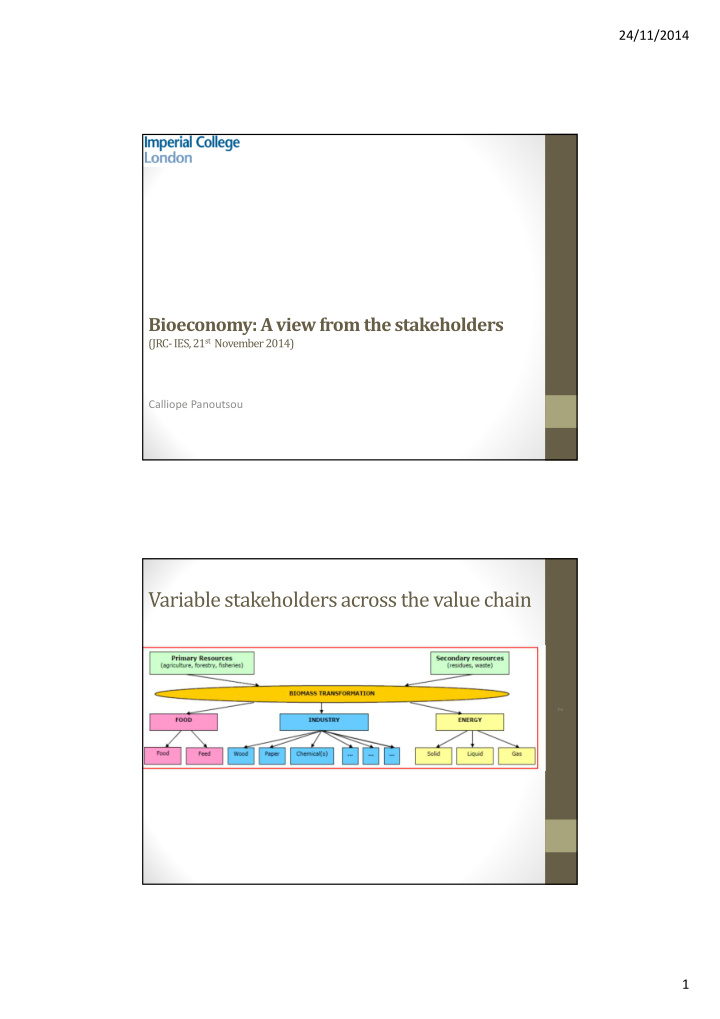



24/11/2014 Bioeconomy: A view from the stakeholders (JRC-IES, 21 st November 2014) Calliope Panoutsou Variable stakeholders across the value chain 2 1
24/11/2014 Complex interactions lead to misleading messages : diverse feedstock, regional characteristics and broad range of markets • Conflicts or synergies among various demand sectors? How to understand and what are the appropriate metrics to evaluate and monitor progress? • What is the value chain potential and what are the issues shaping the sustainable biomass supply and building new value chains? • How do various stakeholder categories react to the opportunities and risks associated with potential impacts of bioeconomy to the economy, society and environment? • How can we maximise benefits and mitigate risks, and through what policy mechanisms/ instruments? • What types of policies are required to create a demand- pull and supply –push bioeconomy? Primary and secondary resources Supply Climate Change, Science Energy, fuels Renewables Biobased Agriculture, Trade Educate Policy . Demand materials Environment, Understand Validate Enterprise Conclude Innovation Review Biodiversity, Land and Sustainability water use . GHG balances Work with each group • Scoping • Debate • Critique • Conclusions 2
24/11/2014 Key issues to facilitate communication • Diversity: diverse range of stakeholders, including farmers, fishermen, food processors, waste handlers, advanced bio-material manufacturers, researchers, educationalists, policy-makers, bio-energy providers, NGOs and civil society. • Flexibility: the bioeconomy is not prescriptive, but allows each country, region, industry and stakeholder • Connectivity: regardless of origin, the basic biomass substrate is a renewable yet finite resource that serves as the raw material for a range of different uses. • Coherence: the bioeconomy requires all actors along the value chain to work together at various levels in a coherent manner if it is to achieve its full potential. • Innovation: …learning from each other, sharing best (and worst) practices, being courageous in taking risks and accepting failures as learning experiences. • Sustainability: European society is moving towards a low-carbon, green economy where consumers are increasingly focusing on health, well-being and sustainable food • Security: the stability and efficient functioning of Europe's bioeconomy is of critical importance to the long-term security of its 500 million people. This concerns not just food security, but the adaptations required to balance an economic use of biological resources with all aspects of conservation of the environment. Key actions to achieve progress • Skilling/Reskilling: realising the full potential of the bioeconomy requires a mix of existing skills and occupations (e.g. farming, fishing, etc.) allied to new high- and low-tech skills in a range of bio-refining and bio-processing technologies. This in turn has implications for educational curricula – from primary education to third and fourth level – which will need to be re-engineered to meet the demands of the bio and green economies of the future. • Wider Horizons: the development of Europe's bioeconomy needs to be seen and planned over much wider dimensions of space and time, addressing its global impact and looking beyond short-term budgetary cycles. In particular, policies and actions to minimise climate change require urgent and consistent priority in the decades ahead. • Close the research-market gap and build an effective dialogue between industry, academia and end-users. • Maximise the knowledge-based development potential of EU regions in the different bioeconomy sectors. • Stronger policy coordination, not only at EU level, but also at national, regional and local level. 3
24/11/2014 Options to engage stakeholders • Ensure appropriate selection and representatives across value chain steps and scales of decision making/ implementation (EU, national, regional, local) • Develop dialogue mechanisms • Reform and translate long scientific reports and modelling to a set of clear messages that each stakeholder group can relate to or will be interested to hear (tackle the issues of ‘ stakeholder fatigue ’ and ‘ lack of real time response ’ to misleading messages). • Engage stakeholders on a continuous basis. • Public awareness is equally important. Thank you! c.panoutsou@imperial.ac.uk 4
Recommend
More recommend